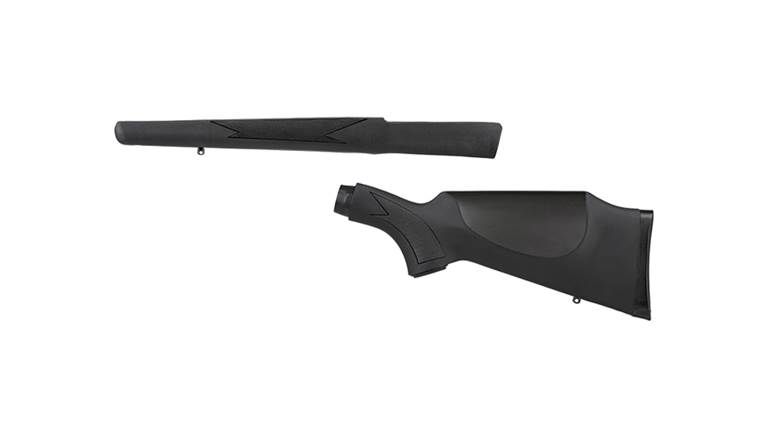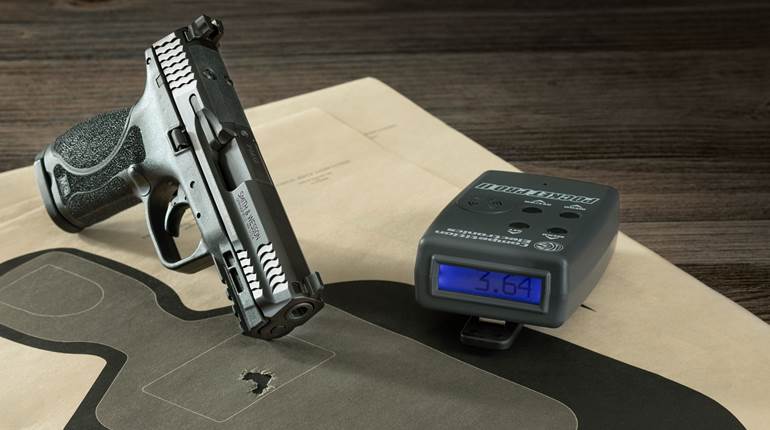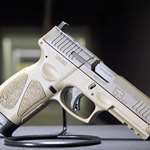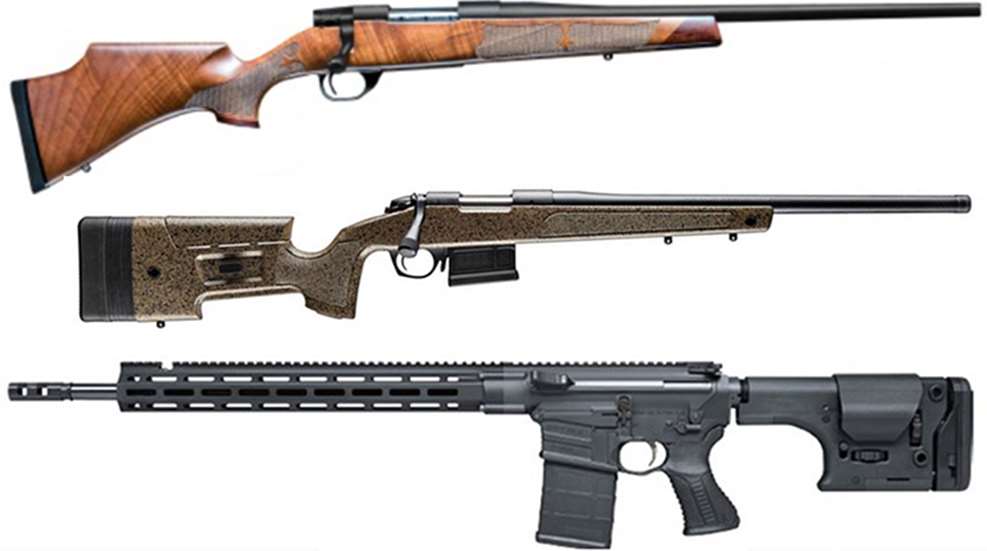
Weatherby Vanguard Camilla, Bergara HMR, Savage MSR 10 Long Range
Like most firearms and their components, rifle stocks have gone through a profound revolution during the past two decades. They used to be made of wood nearly exclusively—usually walnut—and a good one was one that had a pleasing grain figure and sharp, well-cut checkering. Today stocks are made of a variety of modern components, many of the materials concocted by man, others of metal, but fewer are made in the classic walnut. It might be a prudent exercise to examine exactly what a rifle stock is and should be.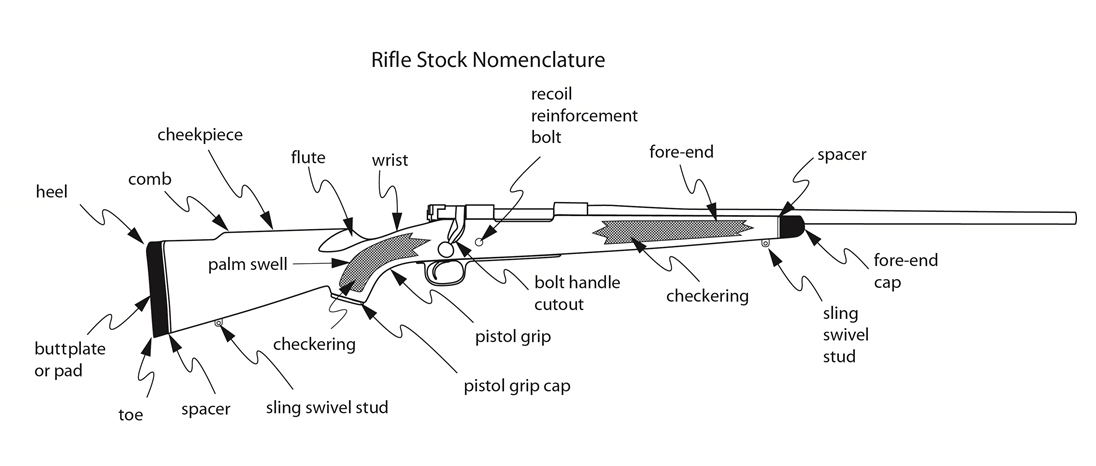
NRA Firearms Sourcebook image
Perhaps the first order of business is to define what a rifle stock is as well as its purpose. A rifle stock is a device that provides an interface between the shooter and the rifle. Its foremost purpose is to allow the shooter a repeatable point of contact in relation to the rifle’s aiming device. Good rifle stocks also should provide rock-solid support of the rifle’s receiver and either have just enough support of the barrel to dampen its accuracy-depriving vibrations, or allow the barrel to vibrate freely and repeatedly. Finally, a good stock allows the shooter to control the rifle and enhance his or her ability to hold the rifle perfectly still for the shot.
Some of the first firearm stocks preceded the concept of rifling—therefore a rifle—and were designed at hand in the field to simply support the firearm and protect the shooter from injury. Many of the 12th and 13th century gonnes were a tube closed at one end, loaded from the muzzle and fitted with a metal spike to be driven into a log at the site and then fired. Thankfully, we have evolved considerably.
Other early rifle stocks had what would now be described as considerable “drop at the comb and heel” because most shooters thought that the only way to shoot a rifle was standing up, with the head erect. These stocks are also quite short by today’s standards in length of pull because most people were shorter several hundred years ago than today. Old World and many New World gunmakers—stock making as a specialty is a relatively new phenomenon—gathered input from their customers and continued to refine the design, execution and materials of their rifle stocks. These early craftsmen often had to find an acceptable compromise since shooting a rifle from different positions—standing, kneeling, prone, from a position of support, etc.—changes the physical relationship of the shooter’s body to the rifle. Adjustable stocks like the ones we see today were not practical until the advent of newer, stronger materials that are lightweight. This first of a two-part article focuses on the primary stock components and design.
Butt
The butt is the primary anchor point of the stock. It transfers the recoil from the rifle to the shooter and restrains the rifle from moving too much. I’m not sure when the first buttplate was invented. Undoubtedly, its primary purpose was to protect the wood at the butt from splintering; later profiles were developed to allow it to be a more secure anchor point.  Kentucky rifles had curved or crescent-shaped buttplates, the idea being that it fit the curvature of the shoulder better and, consequently, would be a better, more repeatable anchor point of the rifle. This notion persisted well into the 19th century and in the development of lever-action rifles. Trouble was—and is—as cartridges increased in power, this style of buttplate became painful, even excruciating to shoot. But there is no denying that they look cool.
Kentucky rifles had curved or crescent-shaped buttplates, the idea being that it fit the curvature of the shoulder better and, consequently, would be a better, more repeatable anchor point of the rifle. This notion persisted well into the 19th century and in the development of lever-action rifles. Trouble was—and is—as cartridges increased in power, this style of buttplate became painful, even excruciating to shoot. But there is no denying that they look cool. 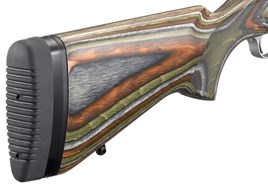
Gunmakers eventually began employing a buttplate like the one developed for shotguns. This style is long enough to cover the shoulder pocket well, and are rather wide, the idea being that the recoil force is spread over a larger surface area of the shoulder, thus making it less painful to shoot. Eventually the idea of padding the buttplate with rubber—occasionally covered with leather—came about, and today it is almost standard on bolt-action rifles, as well as shotguns. (shown: Ruger Guide Gun)
Some of today’s adjustable stocks have a smaller, convex profile. These are usually on relatively low-recoiling cartridges like the 5.56 NATO (.223 Rem.), where the rifle is more likely used in close quarters and it must be allowed to be moved vertically quickly. Target rifles are sometimes seen with an extension at the toe or heel to allow for more precise and repeatable mounting. Schützen stocks take this—as well as other stock components—to a rather obtuse extreme, whether for pragmatic reasons or the maker’s idea of beauty, I am not sure. 
Mossberg MMR Carbine
The Comb
A rifle stock’s comb is arguably the most critical component of the stock, at least in terms of repeatable accuracy. The comb is where you place the stock against your cheek—often referred to as the cheekweld. If it doesn’t allow you to place your cheek in exactly the same spot for every shot then it is near impossible to replicate your sight picture, hence the bullet impact will be different from shot to shot.
Browning's X-Bolt Eclipse Target long range/target rifle stock features a laminated gray satin finish, thumbhole grip, raised cheekpiece, two QD swivel cups, and a glass-bedded, free-floated bull barrel.
Stocks from the 19th and early 20th century often had considerable drop at the comb and heel, a carryover from the only-way-to-shoot-is-standing-up days. The combs of these rifles were also rather sharp and thin, an attempt to make the rifle lighter and easier to carry. However, those sharp combs really rattled one’s dental work, even with relatively mild cartridges like the .30-30 Win. As custom stockmakers blossomed during the period between the two World Wars, so did the notion of adding a cheekpiece to the comb. This provided a raised section of the stock where the cheek rests and removing the excess to save weight. Cheekpieces evolved into stylish additions to the stock, each having a unique profile to suit the aesthetics of the stockmaker. 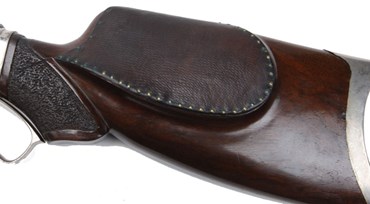
The Brits seem to prefer what is commonly called the “pancake cheekpiece” whereby the raised position looks something like a pancake lopped over the comb. German stockmakers apparently have an affinity for straight lines, square corners and sharp, unbroken edges. American stockmakers, who developed what is known as the Classic Stock, made cheekpieces with a rounded rear portion that straightened and sloped toward the point of the comb, merging with it at that point. Many stockmakers include a shadow line, basically a sharp, straight cut from the sloping part of the cheekpiece to the stock proper. Shadow lines serve no useful purpose other than decoration.
State-of-the-art stocks today have cheekpieces that can be adjusted. There are aftermarket adjustable cheekpieces that can be added to a standard stock, as well. With the advent of optical sights, each having a different centerline above the bore of the rifle has made adjustable combs a more popular addition.
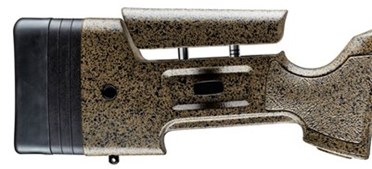
The rear stock of the new Bergara HMR is specifically created to offer a multitude of adjustments for many different types of shooters, both right and left handed. The cheekpiece, or cheek riser, is fully adjustable up and down to accommodate proper eye alignment with the optic for different size shooters.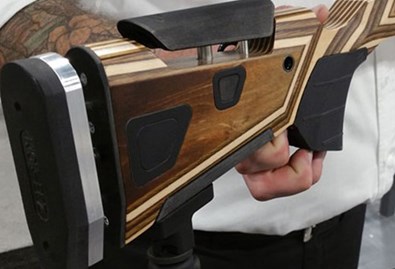
Boyds Gunstocks announced its "At-One Adjustable Modular Rifle Stocks" at SHOT Show 2017.
Grip
The grip—or wrist on conventional stocks—determines how well the shooter will be able to control the stock. Straight or English grips are handy for carrying and make the rifle easier to swing on moving targets, which is why they are popular on shotguns. They are found mostly on conventional lever-action rifles, though occasionally one may be seen on a bolt-action.
Henry Repeating Arms Second Amendment Tribute Rifle
Far and away the most popular grip profile is one of several kinds of pistol grips. Pistol grips can vary from an open circular wrist—sometimes referred to as a quarter grip or Prince of Wales grip—to a tight circle or even a rounded right angle grip. Some stocks are also made with a hole in the stock material for the thumb. Such thumbhole stocks are more useful in the minds of some shooters and stockmakers than are practical. A critical dimension with any pistol grip is what may termed the length of pull from where the web of the thumb contacts the grip to the center of the trigger. Too long, and the shooter must loosen his thumb a bit to be able to reach the trigger properly. This relinquishes control of the shooting hand, thus making it more difficult to shoot the rifle. If this distance is too short, then the trigger finger or even the entire hand can cramp while trying to maintain its control.
On wood stocks, the pistol grip is often capped with steel, aluminum or a contrasting piece of wood. Such grip caps have no practical usage and are for decoration only. Some synthetic stocks have hollowed pistol grips, sometimes seen on AR-style rifles, whereby one can store a sight-adjustment tool or such. If you choose such a feature, make sure the cap latch is plenty robust, otherwise you might find the cap open and your precious, must-have tool is missing in action.
Fore-end
The fore-end has three purposes: It provides protection of the offhand from the heat of the barrel; for bedded barrels, the fore-end is a foundation of the bedding material; and it can be used as an anchoring point for accessories like a sling or bipod.
Fore-ends can be a part of a one-piece stock or a separate component. In the past when barrel making was as much art as science, bedding the barrel helped dampen random vibrations due to internal stresses and variations within the barrel. Today barrel making is far more exact, both in terms of material consistency as well as manufacturing tolerances. Most modern barrels are free floated, meaning that nothing touches the barrel except for where it joins the receiver. Fore-ends for many semi-automatic or selective-fire rifles incorporate Picatinny rails to attach accessories like flashlights or laser aiming devices.
Most fore-ends have some form of gripping surface either cut into them—i.e. checkering or stippling on wood stocks—or molded into them if made from a synthetic material. Fore-ends on rifles designed to be fired from a benchrest are usually smooth with a flat bottom profile.
Coming soon—Part 2: Stock Materials, Bedding and Furniture













